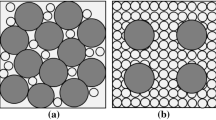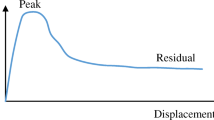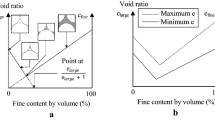Abstract
This paper presents an intensive series of laboratory testing results from vane shear and fall cone tests that were conducted on various clay–sand mixtures to understand the link between these methods which are often used for determining the undrained shear strength (su). Three different gradations (2.0–1.0 mm, 1.0–0.6 mm, and 0.6–0.3 mm) of rounded and angular sands were mixed with low-plasticity clay at ratios of 0%, 10%, 20%, 30%, 40%, and 50%. The results of the tests demonstrated that the su values obtained from the vane shear tests were found to be always higher than those obtained from the fall cone tests. It was shown that the sand content used in the mixtures changed the su parameters of the specimens significantly. The results indicated that the su values were significantly influenced by grading characteristics of the sands (d10, d20, d30, d50, d60, cu, cc). The values of su were lower for the samples that had a larger size of sand grains. Finally, shape characteristics of the sand grains were found to be effective on the results. The samples with angular sand grains have higher su values than the samples with rounded sand grains, for all gradations employed in the present study.













Similar content being viewed by others
References
Abbireddy COR, Clayton CRI, Huvenne VA (2009) A method of estimating the form of fine particulates. Geotechnique 59(6):503–511
ASTM D 2573-94 (American Society for Testing and Materials) (2013) Standard test method for laboratory miniature vane shear test for saturated fine-grained clayey soil. United States, West Conshohocken, pp 19428–12959
Cabalar AF (2010) Applications of the oedometer, triaxial and resonant column tests to the study of micaceous sands. Eng Geol 112:21–28
Cabalar AF (2018) Influence of grain shape and gradation on the shear behavior of sand mixtures. Sci Iran Trans A Civil Eng 25(6):3101–3109
Cabalar AF, Hasan RA (2013) Compressional behaviour of various size/shape sand-clay mixtures with different pore fluids. Eng Geol 164:36–49
Cabalar AF, Mustafa WS (2015) Fall cone tests on clay-sand mixtures. Eng Geol 192:154–165
Cabalar AF, Dulundu K, Tuncay K (2013) Strength of various sands in triaxial and cyclic direct shear tests. Eng Geol 156:92–102
Cedergen HR (1989) Seepage, drainage, and flownets, 3rd edn. Wiley, New York 26
Cho GC, Dodds JS, Santamarina JC (2006) Particle shape effects on packing density, stiffness and strength: natural and crushed sands. J Geotech Geoenviron 132(5):591–602
Claveau-Mallet D, Duhaime F, Chapuis RP (2012) Practical considerations when using the Swedish fall cone. Geotech Test J 35(4):1–11
Clayton CRI, Abbireddy COR, Schiebel R (2009) A method of estimating the form of coarse particulates. Geotechnique 59(6):493–501
Feng TW (2000) Fall-cone penetration and water content relationship of clays. Geotechnique 50(2):181–187
Flaate K (1966) Factors influencing the results of vane tests. Can Geotech J 3:18–31
Gilboy G (1928) The compressibility of sand-mica mixtures. Proc ASCE 2:555–568
Goktepe AB, Sezer A (2010) Effect of particle shape on density and permeability of sands. Proc Instit Civil Eng Geotech Eng 163(6):307–320
Hansbo S (1957) A new approach to the determination of the shear strength of clay by the fall-cone test. R Swed Geotech Inst Proc 14:7–47
Holtz RD, Kovacks WD (1981) An introduction to geotechnical engineering. Prentice-Hall, Englewood Cliffs, NJ, 517
Holubec I, D’Appolonia E (1973) Effect of particle shape on the engineering properties of granular soils. Evaluation of relative density and its role in geotechnical projects involving cohesionless soils. ASTM, STP523, West Conshohocken, pp 304–318
Houlsby GT (1982) Theoretical analysis of the fall-cone test. Geotechnique 32(2):111–118
Kenny TC (1977) Residual strength of mineral mixture. Proc. 9th International Conference of Soil Mechanics and Foundation Engineering, pp 155–160
Kravitz JH (1970) Repeatability of three instruments used to determine the undrained shear strength of extremely weak, saturated, cohesive sediments. J Sediment Petrol 40(3):1026–1037
Krumbein WC (1941) Measurement and geological significance of shape and roundness of sedimentary particles. J Sediment Petrol 11(2):64–72
Krumbein WC, Sloss LL (1963) Stratigraphy and sedimentation, 2nd edn. W.H. Freeman and Company, San Francisco, p 660
Larsson S, Rothhamel M, Jacks G (2009) A laboratory study on strength loss in kaolin surrounding lime-cement columns. Appl Clay Sci 44:116–126
Lee HJ (1985) State of the art: laboratory determination of the strength of marine soils. In: Chaney RC, Demars KR (eds) Strength testing of marine sediments: laboratory and in-situ measurements, ASTM special technical publication 883. ASTM, Philadelphia, pp 181–250
Lees G (1964) A new method for determining the angularity of particles. Sedimentology 3(2):21
Leroueil S, Le Bihan JP (1996) Liquid limits and fall cones. Can Geotech J 33(5):793–798
Lupini JF, Skinner AE, Vaughan PR (1981) The drained residual strength of cohesive soils. Geotechnique 31(2):181–213
McGeary RK (1961) Mechanical packing of spherical particles. J Am Ceram Soc 44(10):513–522
Menzies BK, Merrifield CM (1980) Measurements of shear distribution at the edges of a shear vane blade. Geotechnique 30:314–318
Mitchell JK (1976) Fundamental of soil behaviour. John Wiley & Sons, Inc
Mohsen S, Ullrich CR (1985) Rate of shear effects on vane shear strength. J Geotech Eng 111(1):135–139
Monkul MM, Ozden G (2007) Compressional behavior of clayey sand and transition fines content. Eng Geol 89:195–205
Nagaraj TS, Murthy BRS, Bindumadhava TS (1987) Liquid limit determination further simplified. Geotech Test J 12(4):302–307
Ni Q, Tan TS, Dasari GR, Hight DW (2004) Contribution of fines to the compressive strength of mixed soils. Geotechnique 54(9):561–569
Olson RE, Mesri G (1970) Mechanisms controlling the compressibility of clay. Journal of the Soil Mechanics and Foundations Division, 96 (SM6), Proc. Paper 7649, November, 1863–1878.
Powers MC (1953) A new roundness scale for sedimentary particles. J Sediment Petrol 23(2):117–119
Rahman MM, Lo SR (2008) The prediction of equivalent granular steady state line of loose sand with fines. Geomech Geoeng 3(3):179–190
Seah TH, Sangtian N, Chan IC (2004) Vane shear behavior of soft Bangkok clay. Geotech Test J 27:1–10
Stone KJ, Kyambadde B (2007) Determination of strength and index properties of fine-grained soils using a soil minipenetrometer. J Geotech Geoenviron Eng 133(6):667–674
Stone KJL, Phan KD (1995) Cone penetration tests near the plastic limit. Geotechnique 45(1):155–158
Tan TS, Goh TC, Karunaratne GP, Lee SL (1994) Shear strength of very soft clay-sand mixtures. Geotech Test J 17(1):27–34
Terzaghi K (1925) Erdbaumechanik auf bodenphysikalischer grundlage. Deuticke, Leipzig/Vienna
Terzaghi K (1927) Determination of consistency of soils by means of penetration tests. Public Roads 7(12):240–247
Thevanayagam S (1998) Effect of fines and confining stress on undrained shear strength of silty sands. J Geotech Geoenviron 124(6)
Thevanayagam S, Mohan S (2000) Intergranular state variables and stress–strain behaviour of silty sands. Geotechnique 50(1):1–23
Thevanayagam S, Martin GR, Shenthan T, Liang J (2001) Post-liquefaction pore pressure dissipation and densification in silty soils. In: Prakash S (ed) Proc., 4th International Conferences on Recent Advances in Geotechnical Earthquake Engineering and Soil Dynamics. San Diego
Tiesong L, William RB (1997) Comparison of vane shear and fall cone strengths of soft marine clay. Mar Georesour Geotechnol 15(1):67–82
Troncoso JH, Verdugo R (1985) Silt content and dynamic behavior of tailing sands. Proc. 11th International Conference on Soil Mechanics and Foundation Engineering vol 3, pp 1311–1314.
Wadell H (1932) Volume, shape, and roundness of rock particles. J Geol 40(5):443–451
Wang DX, Zentar R, Abriak NE, Xu WY (2013) Shear strength behavior of cement/lime-solidified Dunkirk sediments by fall cone tests and vane shear tests. Geotech Test J 36(1):1–8
Westerberg B, Muller R, Larsson S (2015) Evaluation of undrained shear strength of Swedish fine-grained sulphide soils. Eng Geol 188:77–87
Wood DM (1982) Cone penetrometer and liquid limit. Geotechnique 32(2):152–157
Wood DM (1985) Some fall cone tests. Geotechnique 35(1):64–68
Yamamuro JA, Wood FM (2004) Effect of depositional method on the undrained behavior and microstructure of sand with silt. Soil Dyn Earthq Eng 24:751–760
Yamamuro JA, Bopp PA, Lade PV (1996) One dimensional compression of sands at high pressures. J Geotech Eng 122(2):147–154
Youd TL (1973) Factors controlling maximum and minimum densities of sands, evaluation of relative density and its role in geotechnical projects involving cohesionless soils. ASTM STP 523:98–112
Author information
Authors and Affiliations
Corresponding author
Additional information
Responsible Editor: Zeynal Abiddin Erguler
Rights and permissions
About this article
Cite this article
Cabalar, A.F., Khalaf, M.M. & Isik, H. A comparative study on the undrained shear strength results of fall cone and vane shear tests in sand–clay mixtures. Arab J Geosci 13, 395 (2020). https://doi.org/10.1007/s12517-020-05351-5
Received:
Accepted:
Published:
DOI: https://doi.org/10.1007/s12517-020-05351-5




